How to Create Your Own Generative AI Solution: Guide Uncovering Best Practices
14 Jul 2025
19 Min
116 Views
To automate routine processes, boost efficiency, and elevate customer experience, it may be the right moment to consider building your own generative AI model. Generative AI can help you create personalized, intelligent solutions that adapt to user needs, reduce manual effort, and unlock new growth opportunities.
Technically, generative AI (Gen AI) has become one of the fastest, most effective ways to optimize operations, enhance user experiences, and stay competitive. To facilitate effective work that brings an expanded user base and profit, it’s important to learn approaches and tools that will seamlessly integrate within your business identity and workflows.
In this guide, you'll gain a practical understanding of what generative AI is, how it works, and why it's becoming a strategic advantage for forward-thinking companies. We’ll walk you through how to approach building your own generative AI solution, from initial planning to successful deployment, while also exploring real-world applications across industries.
Key takeaways from this guide:
- Generative AI is a type of artificial intelligence that generates text, images, audio, or other content by learning patterns from vast datasets and mimicking human-like output.
- Building a generative AI solution involves defining business goals, preparing high-quality training data, selecting the right base model, and integrating it into your existing tech ecosystem.
- Use cases for Generative AI span multiple industries automating document handling in insurance, powering virtual assistants in fintech, and scaling multilingual content in media.
- Successful Gen AI adoption depends on strategic planning, ethical data use, cloud infrastructure readiness, and continuous model monitoring to ensure accuracy and relevance.
What Is a Generative AI Model?
Generative AI models are a form of artificial intelligence that creates new content based on patterns learned from large amounts of data. This content can include text, images, audio, video, or code, generated with context and creativity that mimics human output.
Gen AI models often rely on deep learning, transformer architectures, and generative adversarial networks to enhance realism and accuracy. A generative AI application or full-scale generative AI system can be used across industries to automate and personalize workflows.
Here are examples of the most popular Gen AI models and what they’re capable of doing:
- ChatGPT (text). ChatGPT is a generative AI model that creates coherent, human-like text in response to prompts. It can generate answers, emails, articles, stories, and more. Widely used in support, education, and content creation.
- DALL·E (images). DALL·E generates images from text descriptions using deep learning. It can visualize anything from realistic portraits to surreal concepts. Ideal for design, marketing, and creative storytelling.
- MusicLM (audio). MusicLM creates music tracks from natural language prompts, supporting different genres, moods, and instruments. It's useful for composers, content creators, and audio design automation.
- Sora (video). Sora is a generative AI that turns text descriptions into short video clips. It captures motion, scenes, and detail, making it ideal for film, advertising, and education.
Generative AI models predict the most probable next element (word, image pixel, audio sample, etc.) based on context. All these result in flexible, personalized, and often creative and high-quality output generated in real time.
Gen AI systems rely on deep neural networks that analyze complex patterns across structured and unstructured data. Once trained, these models can understand prompts and generate responses that are not only relevant but also contextually rich and coherent.
Below, you can examine the generative AI models' functioning stages:
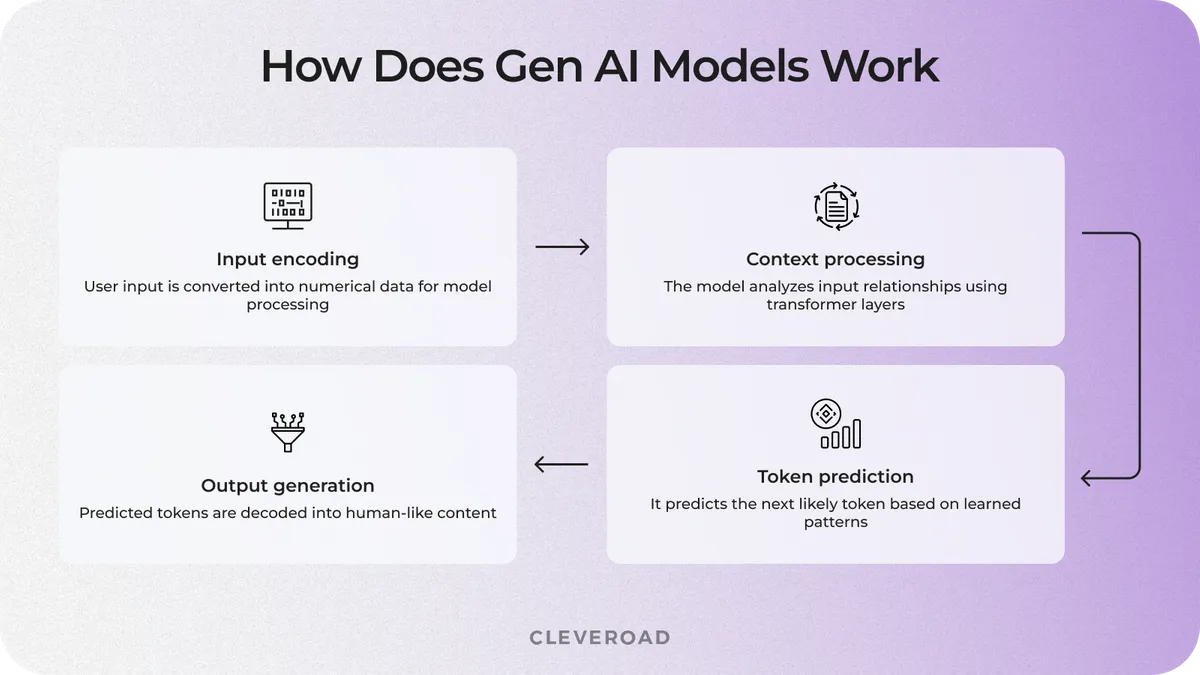
Work principle of Gen AI models
5 Steps to Build Your Own Generative AI Model
As an IT vendor with deep expertise in AI-powered solutions, Cleveroad is here to guide you through the key stages of generative AI model development. We consulted with our in-house AI team and are sharing the exact flow they follow when designing and deploying robust generative AI systems for our clients.
Below, you’ll find a comprehensive development and implementation roadmap tailored to help you build, fine-tune, and integrate a high-performing Gen AI model effectively.
Step 1. Define the gen AI implementation objectives
First of all, start by identifying what you want generative AI to accomplish for your business. Clear and structured goals will guide your technical decisions, whether you’re looking to automate support responses, generate tailored marketing content, enhance internal tools, or build an entirely new user experience. Define KPIs around output quality, processing speed, integration complexity, and security requirements. You should follow a focused scope early on to minimize implementation risks and accelerate outcomes, especially if you're looking to create a Gen AI model tailored to your specific business needs and workflows.
Step 2. Identify suitable gen AI use case
Before starting the development, you should define how generative AI will serve your business goals. Depending on your industry, operations, and automation priorities, the right use case can vary significantly, from content generation to smart decision-making.
Let’s see how it works within several business domains:
- A fintech platform can implement Gen AI to automate client onboarding with KYC assistants.
- A logistics company might use it to generate delivery forecasts or auto-fill documents.
- A retail brand could build a Gen AI-driven engine that personalizes offers in real time.
The use case should align with your existing workflows and deliver clear business value, whether it’s time savings, cost reduction, or experience enhancement. Cleveroad’s AI integration team is ready to help you identify gen AI use cases that bring the most value to your business processes within our comprehensive AI consulting services.
Step 3. Prepare training data
The quality of your training data directly affects the performance, reliability, and fairness of your generative AI model. At this stage, it's essential to gather relevant, domain-specific datasets, clean them from noise and inconsistencies, and ensure they match the task you're automating. Data should be representative of real-world use cases and compliant with any industry-specific regulations, especially in finance, healthcare, or law.
To ensure your model learns meaningfully, additional preprocessing steps are needed: bias detection, data balancing, structured labeling, and format unification. This is the groundwork that powers accurate contextual prediction later in the pipeline.
From this stage, it’s best to build generative AI solutions in collaboration with experienced AI partners who understand the data demands of production-ready systems.
At Cleveroad, we help clients prepare high-quality training data by designing secure, regulation-aligned data pipelines, cleansing raw input, and structuring datasets for model efficiency. We also streamline training workflows using tools like Vertex AI, ensuring optimized, scalable pipelines that reduce overhead and speed up development.
Learn about generative AI services we provide businesses to enhance their internal operations and profit capabilities
Step 4. Select and train a generative AI model
You IT vendor will help you choose a base model based on your use case: GPT-4 for conversational AI, DALL·E or Stability AI for imagery, Claude for alignment-focused applications, or LLaMA for performance-flexible workloads, etc. Depending on your needs, you can start with a pretrained model or create GenAI from scratch. If you’re planning to build generative AI tailored to your product or infrastructure, this is the stage where architectural design and cloud strategy must be closely aligned to ensure scalability, reliability, and seamless integration.
For example, we at Cleveroad help businesses design resilient and scalable GenAI systems swiftly using Amazon Bedrock, Vertext AI, and an Azure OpenAI Service. Moreover, as an AWS Select Tier Partner, we power your gen AI model building and implementations using AWS AI tools that are tailored to both startup agility and enterprise-grade complexity:
- Cloud-native model deployment using Amazon SageMaker and AWS Lambda for scalable, serverless architecture
- Access to pre-trained foundation models via Amazon Bedrock, including models from Anthropic (Claude), Meta (LLaMA), Stability AI (Stable Diffusion), and others
- Scalable training pipelines using SageMaker Pipelines and AWS Trainium for high-performance, cost-efficient model training
Step 5. Fine-tune your gen AI model
Fine-tuning adjusts the generative AI model to reflect your specific tone, structure, and decision logic. This step ensures your AI speaks your brand language, understands your industry nuances, and performs reliably under edge cases. You'll need iterative validation, performance scoring, and continuous model evaluation.
Cleveroad implements advanced fine-tuning pipelines using tools like SageMaker Hugging Face Estimators, LoRA (Low-Rank Adaptation) for parameter-efficient tuning, and RLHF (Reinforcement Learning with Human Feedback) where applicable. These pipelines include multi-stage training loops, prompt evaluation sets, and fallback logic to ensure resilience and context-appropriate output. We also integrate automated model versioning, A/B testing frameworks, and prompt injection mitigation to maintain high-quality performance across use cases. This approach allows you to build a generative AI model that integrates seamlessly with your product ecosystem and governance standards.
Step 6. Integrate generative AI in your workflows
Finally, your AI model must now be embedded into real products or processes. This means that at this stage, your team develops robust APIs, plug-ins, or UI components and ensures smooth orchestration with existing systems, whether it’s a CRM, support tool, or frontend app.
At Cleveroad, we use AWS-native tools like API Gateway, Lambda, and Lex to build integration-ready solutions that are scalable, low-latency, and secure. We also establish observability stacks using Amazon CloudWatch and Model Monitor to track performance drift, ensure uptime, and support continuous improvement. This final step brings together all prior work, completing the process of building generative AI that delivers measurable value at scale.
Use Cases of Gen AI Models by Industry
Generative AI models drive business efficiency and success through a combination of powerful mechanisms. Transformer architectures enable deep contextual understanding, allowing the models to generate accurate, human-like outputs. These models can be quickly fine-tuned for specific business needs, saving time and resources, by being pretrained on vast datasets.
Generative AI models' ability to automate creative and analytical tasks at scale frees up teams to focus on higher-value work. Below, we’ll discuss how creating a GenAI model can be beneficial within various industries.
Gen AI in FinTech
Generative AI in FinTech is creating leaps in financial services by automating interactions, speeding document workflows, and enabling synthetic transaction data for safer model development. Here are key applications of Gen AI in FinTech:
- Chatbots and virtual assistants that automate balance checks, multilingual support, etc.
- IDP processes that loan apps and compliance docs via OCR and layout models
- Synthetic data generation that creates realistic financial scenarios for testing
Example: HSBC’s AI virtual assistant handles thousands of daily inquiries, reducing call volumes by 20% and increasing satisfaction by 50%.
By the way, at Cleveroad, we have vast experience in delivering high-quality FinTech software products of different complexity, so our FinTech clients consistently see strong results from working with us.
One example is our collaboration with the Irish financial company Mangopay, a trusted provider of flexible payment systems used by over 2,500 European platforms, including well-known names like Vinted, Rakuten, and Wallapop. Backed by Advent International, Mangopay specializes in tailored payment infrastructure for C2C, B2C, B2B, and marketplace models.
Mangopay partnered with us through our IT staff augmentation services to enhance their core financing platform and launch a new FinTech product built to meet strict security and compliance standards, including KYC and AML. Together, we developed a comprehensive money movement solution featuring multi-currency pricing, e-wallets, treasury tools, and global payouts, ensuring seamless financial operations across any type of platform.
Here’s what Kirk Donohoe, CPO at Mangopay, says about our collaboration:
Kirk Donohoe, CPO at Mangopay provides feedback about collaboration with Cleveroad
Gen AI in Logistics
Leading logistics businesses and enterprises create their own generative AI models to automate document processing, support operational staff, and power intelligent simulations for supply chain optimization. The key Gen AI solutions within the logistics domain include:
- Chatbots & assistants that provide real-time shipping updates and routing info
- IDP to automate bill of lading and invoice handling
- Synthetic data generation that help to simulate capacity planning and route optimization
Example: DHL Supply Chain, in collaboration with BCG, leverages generative AI to automatically generate personalized RFQs (Requests for Quotation) and cleanse unstructured logistics data. This approach has cut proposal preparation time by half while enhancing accuracy and customer relevance through AI-generated documentation.
Gen AI in Education
Educational platforms use Gen AI to deliver personalized learning, 24/7 tutoring, automated content creation, and admin automation. Generative AI models help to facilitate simplified learning in the following ways:
- Hyper personalization that tailors coursework via behavior-based recommendations
- Chatbots & AI tutors to provide real-time Q&A and support
- Content generation that auto-creates quizzes, lesson materials, and summaries
Example: Pearson launched AI tutors and assignment-generation tools in Pearson+, enhancing learning personalization and supporting teachers with content creation.
Gen AI in Healthcare
Healthcare practices and institutions use Gen AI to reduce administrative burdens, improve documentation, and enhance patient care while maintaining strict compliance. Most commonly, medical businesses implement this generative AI solutions:
- Chatbots & voice assistants to manage appointment scheduling and patient triage
- IDP that extracts structured data from EHRs and clinical reports
- Synthetic data that enables model training on privacy-protected patient scenarios
Example: Kaiser Permanente rolled out AI scribe tech across 40 hospitals, saving clinicians hours daily through AI-generated clinical notes drafting.
Want to dive deeper into what benefits AI and automation in healthcare may bring your business? Check out our extensive guide
Generative AI Models Implementation Success Stories
Successful examples of creating a generative AI model and extracting the most from it are definitely the best inspirer and motivation driver. See how leading world companies and enterprises have already implemented generative AI models below.
Morgan Stanley
Morgan Stanley has integrated generative AI internally with tools like AI @ Morgan Stanley Assistant and Debrief, powered by GPT‑4. Gen AIs assist financial advisors by summarizing client meetings, pulling insights from vast internal research, and drafting follow-up communications, helping save roughly 30 minutes per meeting. Nearly all wealth teams now use these tools, which are integrated with internal compliance workflows and UX designed for advisor efficiency.
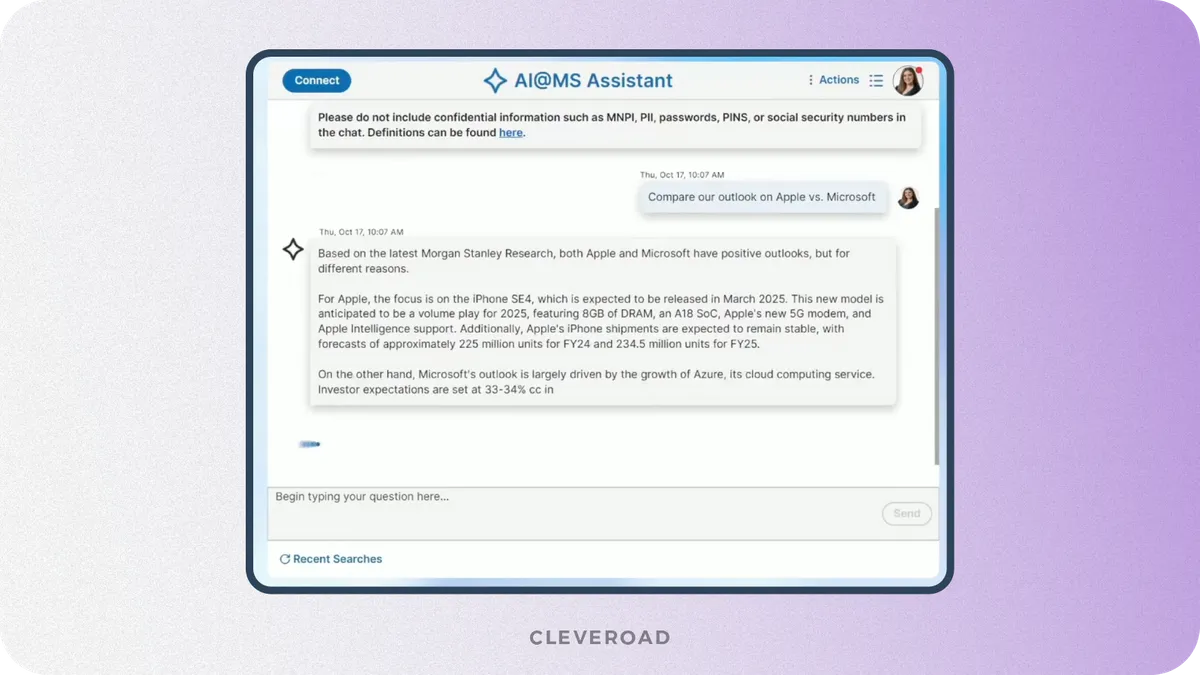
AI @ Morgan Stanley Assistant
Unilever
Unilever leverages generative AI via its Gen AI Content Studios, which uses Nvidia Omniverse to produce thousands of product visuals weekly, up from a handful per month, cutting costs by 50% and doubling speed. Digital twins of products allow consistent branding across formats. This powered a viral Dove × Crumbl collaboration yielding 3.5 billion impressions and 52% new‐customer sales.

Dove x Crumbl campaign by Unilever
Here’s what Steve McCrystal, chief enterprise and technology officer at Unilever, has in mind based on the Unilever experience of incorporating AI:
Steve McCrystal
CETO at Unilever
‘Generating more demand for products, especially through social media, is now a key priority for the tech team. But to equip its army of influencers, Unilever needs to create exponentially more “assets,” or visual components. That’s where AI comes in’
Volkswagen Group
Volkswagen, in collaboration with Cerence, integrated the Cerence Chat Pro generative AI into its IDA in‑car voice assistant. Built on ChatGPT and fine‑tuned with Volkswagen’s automotive data, it enables conversational interactions for navigation, infotainment, and queries via voice, designed with driver safety in mind.
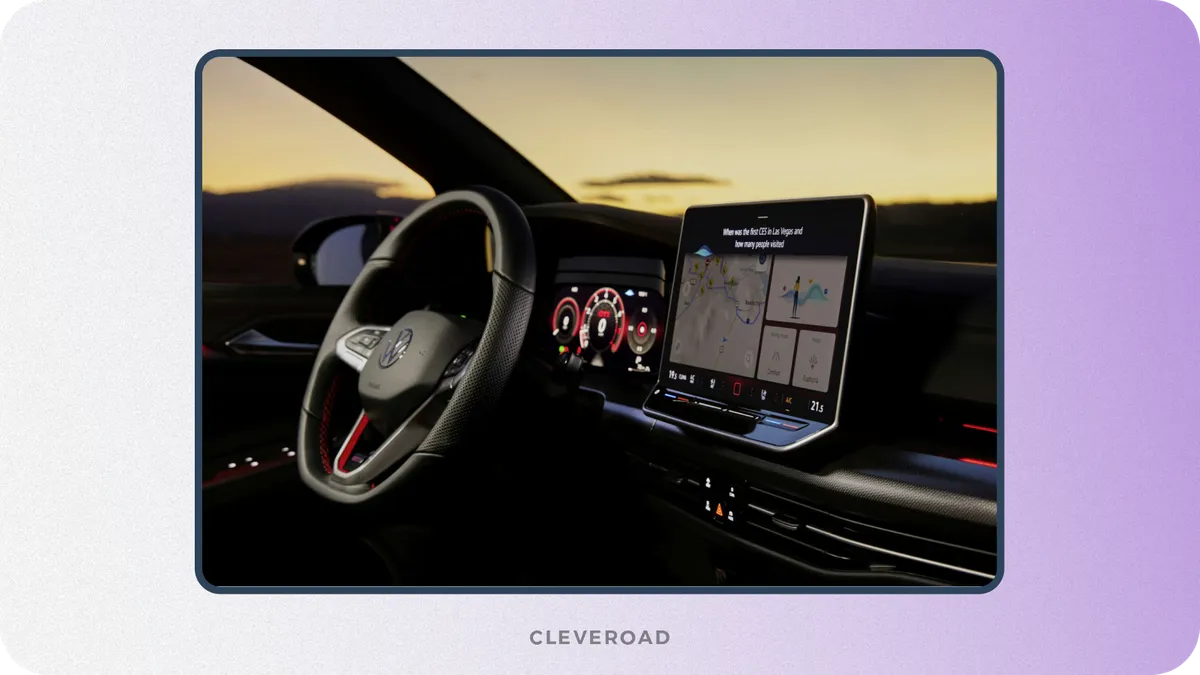
AI IDA in‑car voice assistant by Volkswagen
Best Practices for Successful Gen AI Model Adoption
As generative AI is still a relatively new approach for business automation, there is a high probability of you encountering particular challenges on the way. To help you avoid and minimize it, we’ve outlined several tips for you to ensure the success of your Gen AI model implementation.
Thoroughly prepare datasets
Before you even touch model training, your data needs to be clean, consistent, and relevant. That means removing duplicates, fixing formatting issues, labeling where needed, and filtering out noise. The quality of your input data directly impacts how useful and accurate the results are. If you're planning to create a generative AI model, start by making sure your dataset is airtight.
During collaboration, Cleveroad helps thoroughly prepare datasets by aggregating and cleaning raw data, applying bias detection and balancing, and performing precise labeling tailored to your domain. We design secure, compliant data pipelines that ensure quality and consistency, enabling your generative AI model to learn meaningful patterns efficiently and fairly.
Start with simple AI models
Primarily it’s important not to jump into massive architectures right away. Begin with a smaller, easier-to-manage model to test ideas and workflows. This helps you validate your data and see if your use case makes sense for Gen AI without wasting resources. Smaller models are faster to train, cheaper to run, and easier to tweak. Once you’re confident with the results, you can scale up and experiment with larger models like GPT-4 or LLaMA. That’s the safest way to build your own generative AI without overcommitting too soon.
At Cleveroad, we can quickly develop an AI Proof of Concept (PoC) based on pre-trained generative AI models to help you test whether generative AI will effectively support your business goals.
A PoC in the AI context is a small-scale, functional prototype designed to validate the feasibility and value of AI integration before full-scale development. Typically, we deliver these PoCs within 2-3 weeks, allowing you to assess potential benefits and make informed decisions with minimal risk and investment.
Learn more about AI PoC services we provide at Cleveroad and how it may help you save up on time and budget suring the first Gen Ai model launch
Focus on data security and privacy
When building a Gen AI model, don’t overlook how and where your data is handled. Make sure you’re storing sensitive info in encrypted formats, using secure cloud environments, and following regional privacy regulations like GDPR or HIPAA. Also, avoid using personally identifiable data unless absolutely necessary. If you’re working with third-party tools or vendors, verify their security credentials. Protecting your data builds trust with users and keeps you safe from legal trouble later. It’s especially critical if you plan to create own generative AI that interacts with sensitive information.
At Cleveroad, we ensure your generative AI solution meets the highest standards of data security and privacy, especially for compliance-heavy domains like healthcare or finance. When handling sensitive data, we rely on HIPAA-compatible AWS services and configure encryption protocols to secure data both in transit and at rest.
We leverage the following AWS tools to support regulatory compliance:
- Amazon Comprehend Medical – extracts diagnoses and symptoms from medical text
- Amazon Transcribe Medical – converts physician-patient speech into structured transcripts
- Amazon SageMaker – trains and deploys custom machine learning models securely
- Amazon Transcribe – converts spoken language into text in real-time
- Amazon Comprehend – analyzes text sentiment and extracts entities
- Amazon Polly – transforms text into natural-sounding speech
- AWS Lambda – executes serverless AI tasks with HIPAA-ready configuration
In addition, we set up end-to-end encryption for all data exchanged between your Gen AI solution and other business software, ensuring your system remains secure, compliant, and integration-ready.
Update and tune your Gen AI model
Generative AI models aren’t really “set and forget” case. They need to evolve with your data, users, and goals. Schedule regular fine-tuning cycles to keep the model aligned with changing trends, terminology, or product updates. Monitor how it's performing, track quality, accuracy, and user feedback. Then retrain or adjust it accordingly. You can use tools like prompt tuning, LoRA, or even reinforcement learning for more precise control. Treat your model like software, it needs maintenance, upgrades, and performance checks to stay sharp and useful.
Get to know more about AI development services we provide at Cleveroad and how we help businesses automate manual work, generate profit faster, and seamlessly drive innovations
Cost to Implement a Gen AI Model
The rough cost range to build a generative AI model is around $60,000-$100,000+ for a basic generative AI using pre-trained models, and exceeds $300,000-$500,000+ for advanced solutions.
Generative AI model cost range depends on model complexity, data, infrastructure, and integration needs. All factors influencing gen AI development price include:
- Model type (pre-trained vs. custom): Pre-trained models (like GPT-4 or Claude) reduce time and cost but may limit flexibility. Custom models require more time and resources but can be tailored exactly to your domain and goals.
- Data prep (cleaning, labeling): Data preparation, cleaning, labeling, balancing, is labor-intensive but essential for accurate, unbiased results. Poor data input leads to weak, unreliable outputs.
- Model size & architecture: Larger models with more parameters offer higher accuracy and capabilities but significantly increase training time, compute requirements, and cloud costs.
- Cloud infrastructure (AWS, Azure, GCP): The choice of cloud provider and tools (e.g., Vertex AI, SageMaker) affects latency, pricing models, and integration speed with tech stack.
- Security & compliance (e.g., KYC, AML): AI models in finance, healthcare, or legal domains must meet strict regulatory standards. Implementing compliance mechanisms like KYC/AML adds to development complexity and cost.
- Integration scope (apps, APIs): Seamless integration with your existing systems (mobile/web apps, CRMs, analytics tools) requires additional development effort, especially when real-time response is expected.
- Post-launch tuning & monitoring: Ongoing model evaluation, retraining, and monitoring (e.g., via CloudWatch, Model Monitor) are critical to avoid drift and maintain quality, this adds long-term operational overhead.
- Team setup (in-house vs. vendor): Building internally may offer more control but demands experienced AI talent and infrastructure. Partnering with a vendor speeds up delivery and reduces hiring risks, but requires good alignment.
Based on our experience in AI solutions delivery, below we’ve compiled an approximate estimate of generative AI solutions costs based on their complexity.
| Gen AI model complexity level | Gen AI model use case | Tech scope | Gen AI model estimated cost ($) |
Basic | Chatbot, email writer, content summarizer | API-based, pre-trained model (e.g., GPT-4 via Bedrock) | $60,000-$100,000 |
Mid-level | Industry-specific assistant, document processor | Fine-tuned model, moderate integration, cloud infra setup | $100,000-$250,000 |
Advanced | Personalized tutor, AI voice bot, smart data explorer | Multi-modal or custom-tuned, secure APIs, compliance ready | $250,000 – $400,000 |
Enterprise-grade | Proprietary models, global-scale AI systems | Custom-trained, distributed infra, monitoring pipelines | $400,000 – $500,000+ |
Note: The estimates above are approximate and may vary heavily depending on your unique business needs. For more clarity about your specific generative AI model concept, feel free to contact us.
Cleveroad – Your Reliable IT Partner for Generative AI Model Implementation
Cleveroad is a trusted tech partner with 13+ years in software engineering and a proven track record Generative AI models building since 2023.
Here are the key benefits you’ll receive by collaborating with us for Gen AI development:
- A team of experienced Gen AI integrators skilled in NLP, synthetic data, Large Language Models (LLMs) implementation, and high-load Gen AI systems.
- Flexible collaboration models for generative AI building includingIT staff augmentation, dedicated AI development team, or custom gen AI development.
- We support you at every stage of creating generative AI, from business goal analysis and use case identification to model design, to deployment, optimization, and post-launch tuning.
- Enterprise-grade compliance and quality proved by Cleveroad’s ISO/IEC 27001:2013 and ISO 9001:2015 certifications for security management and quality management systems.
- Frictionless integration with Gen AI ecosystems including OpenAI, Hugging Face, AWS Bedrock, Meta AI, Google Vertex AI and other major tools.
We have a proven track record of delivering AI-powered solutions for businesses of different scales. We’d like to tell you about our recent projects - an AI-driven document intelligence and a generative AI tool for automated content creation.
AI-driven document intelligence
Cleveroad developed an advanced AI-powered Intelligent Document Processing (IDP) solution specifically designed for the client’s insurance workflows. The system leverages machine learning and document understanding models to automatically classify document types, extract structured data with high precision, and integrate smoothly with internal platforms, significantly minimizing manual intervention.
As a result, the client gained a robust Gen AI-driven IDP platform that cut document processing time by up to 75%, enhanced compliance preparedness, and accelerated both claims and policy workflows, leading to measurable gains in operational efficiency and customer service quality.
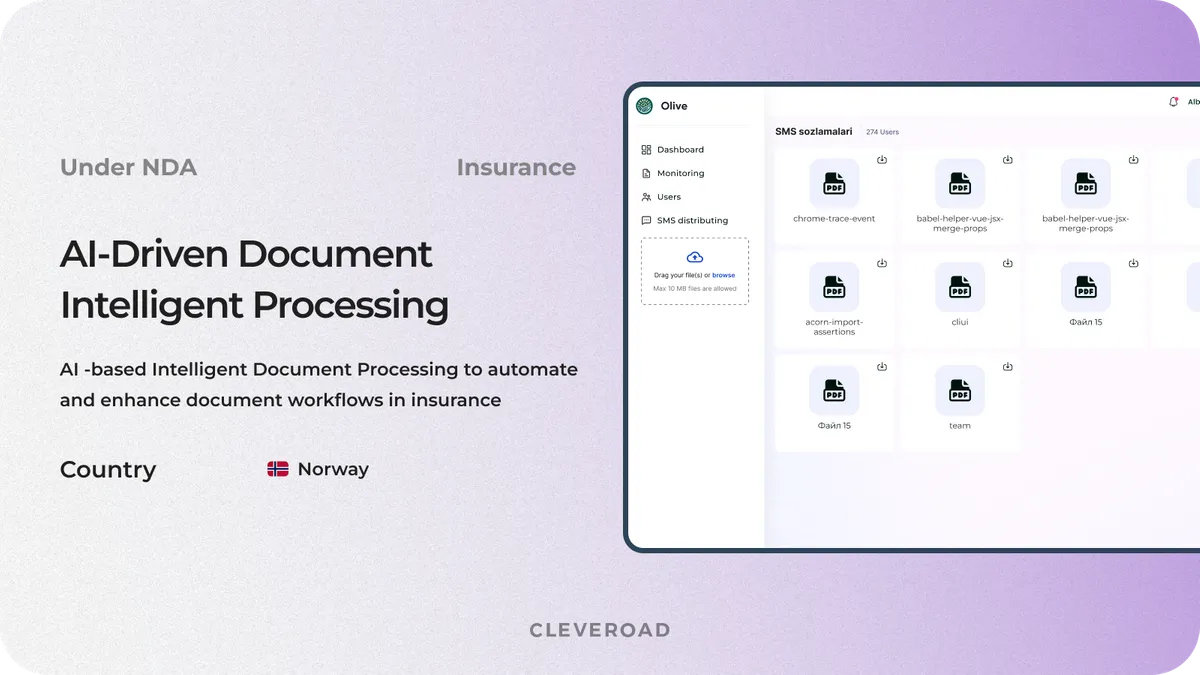
AI-driven document intelligence designed by Cleveroad
AI tools for automated content creation
Cleveroad built a Generative AI-powered content automation system to streamline content creation across the client’s editorial and marketing teams. Using large language models fine-tuned on domain-specific data, the tool generates articles, summaries, titles, and metadata with high contextual accuracy. It integrates directly with the client’s CMS, supporting multilingual output and cross-team collaboration.
The solution automated up to 87% of repetitive content tasks, improved content production speed by 51%, and enabled faster campaign execution, boosting team efficiency while maintaining consistent brand voice and editorial standards.
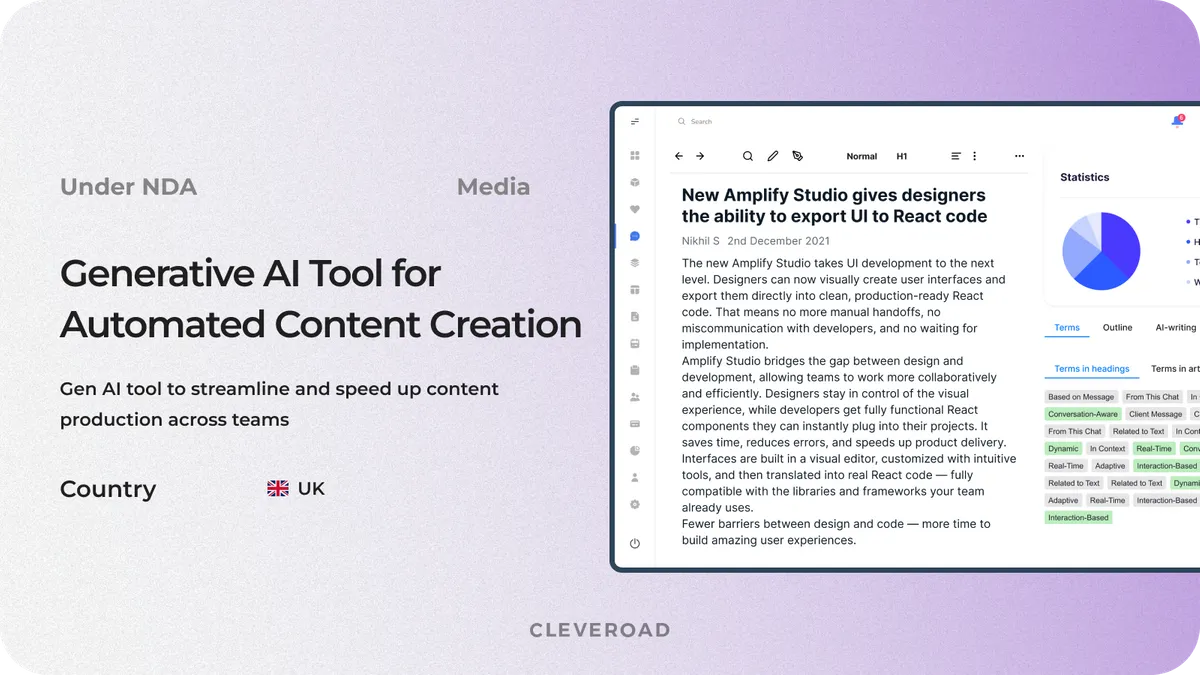
AI tools for automated content creation designed by Cleveroad
Build an intelligent generative AI model with us
Cleveroad’s AI team, equipped with knowledge of building robust AI-powered solutions, is ready to help you create a Gen AI model to automate content-heavy workflows and personalize user experiences
Building a generative artificial intelligence model allows you to automate content creation, streamline decision-making, enhance customer experiences, and unlock new business value. Generative AI enables your systems to generate human-like text, images, or other outputs based on your unique data, making it ideal for personalized services, internal efficiency, and innovative product development. By leveraging generative AI technologies and AI workflows, companies can execute a wide variety of generative tasks across domains.
AI application of this kind relies on powerful machine learning models and AI algorithms that are trained on vast amounts of data. A typical generative AI solution involves selecting a generative model, preparing your data and model, and applying a purpose-fit AI engine capable of performing at scale. This is especially relevant for businesses using models like ChatGPT, generative AI on Vertex AI, or deploying on Google Cloud.
To build a generative AI solution, follow these steps:
- Step 1. Define the generative AI development objective
- Step 2. Identify suitable genAI use case
- Step 3. Prepare training data
- Step 4. Select and train the model
- Step 5. Fine-tune your model (once the model is trained)
- Step 6. Integrate into existing AI app or build a new custom generative AI stack
You may also choose to build a custom solution using generative AI foundation models like GPT-4 or Claude, depending on your business case. Developing a generative AI model with the help of a robust AI vendor ensures scalability and compliance.
The cost to create a generative AI model ranges from $60,000 to $500,000+, depending on model complexity, data prep, infrastructure, and integration scope. Pre-trained various generative models with light customization are more affordable, while developing generative AI models from scratch or at enterprise scale demands higher investment. Businesses using platforms like Generative AI on Vertex AI or Google Cloud benefit from flexible compute and prebuilt pipelines.
AI offers faster content production, automation of manual tasks, and smarter decision-making. Generative AI helps improve personalization, support multilingual output, and surface predictive insights. AI can help improve workflows, reduce time-to-market, and cut operational costs. Moreover, AI can alter how businesses approach product innovation and content strategy. With the right AI capabilities, you can deliver smarter, more engaging customer experiences.

Evgeniy Altynpara is a CTO and member of the Forbes Councils’ community of tech professionals. He is an expert in software development and technological entrepreneurship and has 10+years of experience in digital transformation consulting in Healthcare, FinTech, Supply Chain and Logistics
Give us your impressions about this article
Give us your impressions about this article
